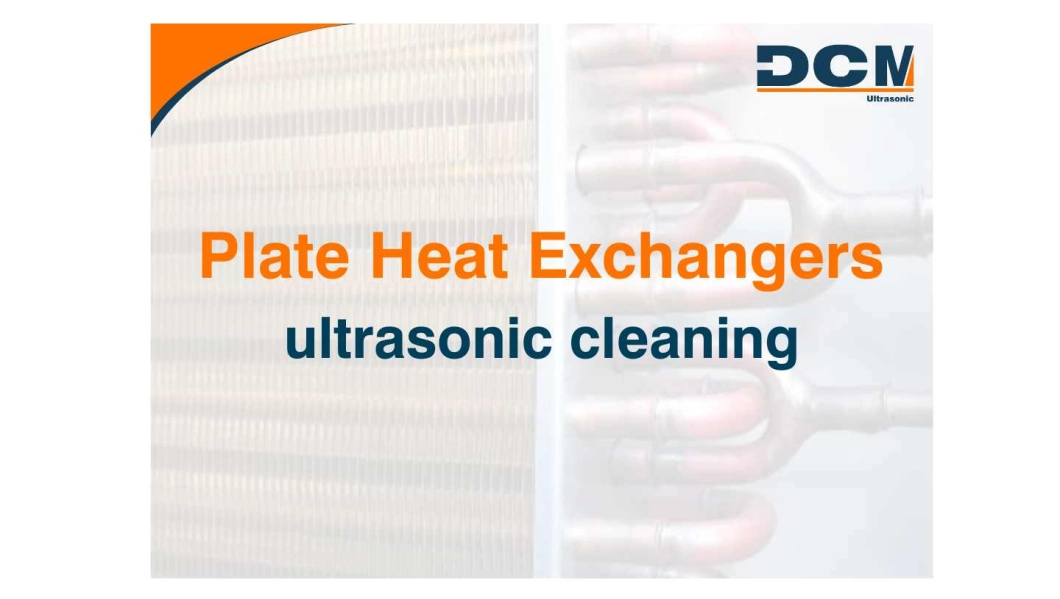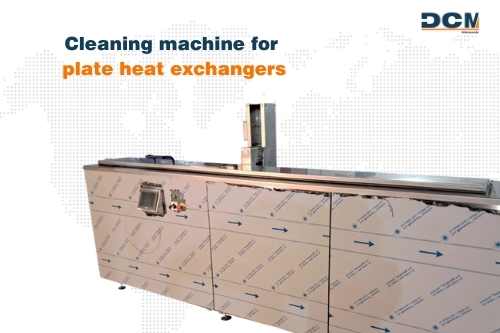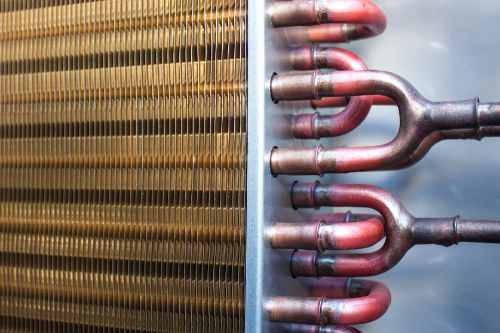Wed, 05 Mar 2025 12:54:22 +0100

One of the most advanced methods for cleaning plate heat exchangers is the use of ultrasound. This technology allows for deep and uniform removal of residues without damaging the surfaces, ensuring optimal maintenance and prolonging the useful life of the equipment.
Proper preventative maintenance, through efficient cleaning, helps to avoid these problems and optimize system performance.
Conventional methods for cleaning plate heat exchangers include:
Although these techniques can be effective, they have disadvantages such as prolonged downtime, risk of plate damage, and the environmental impact of the chemicals used.
MACHINE FOR CLEANING HEAT EXCHANGER PLATES

Ultrasonic cleaning is a highly efficient process that uses high-frequency sound waves to generate cavitation in a cleaning liquid. This phenomenon produces microbubbles that implode, generating mechanical energy capable of removing contaminants without affecting the structure of the plates.
The ultrasonic cleaning process is carried out in the following steps:
1. Disassembly of the plate heat exchanger
The plates are separated and inspected to identify the degree of dirt and possible damage.
2. Placement in the ultrasonic tank
The plates are introduced into a tank with a suitable cleaning solution.
3. Activation of the ultrasonic system
Cavitation is generated, allowing the ultrasonic waves to remove dirt homogeneously.
4. Rinsing and drying
The plates are rinsed to remove residue and dried before reassembly.
5. Final inspection and assembly
The cleaning is inspected and the plates are reassembled for normal operation.

Factors to consider in ultrasonic cleaning heat exchanger plates
WE HELP YOU CLEAN YOUR PLATE EXCHANGERS
Companies in the food, pharmaceutical and energy sectors have reported significant improvements in the efficiency of their heat exchangers by implementing ultrasonic cleaning. Some observed benefits include: Reduction of cleaning time by 50%, complete removal of scale without the need for total disassembly and a lower frequency of corrective maintenance.
Ultrasonic cleaning is an innovative, effective and sustainable solution for the maintenance of plate heat exchangers. Its ability to remove scale evenly, without affecting the integrity of the equipment and reducing the environmental impact, makes it the best option for industries looking to optimize their processes.
At DCM Ultrasonic, we have specialized equipment for cleaning plate heat exchangers, guaranteeing superior results and more efficient maintenance. Contact us to learn more about our solutions and how we can help you improve the performance of your equipment.

News
Cleaning Plate Heat Exchangers with Ultrasonics
05 March de 2025
Plate heat exchangers are essential components in multiple industries, such as the food, pharmaceutical, petrochemical and power generation industries. Their function is to facilitate heat transfer between fluids without mixing. However, over time, these devices accumulate lime deposits, oxides, grease and other contaminants that reduce their efficiency and can compromise their operation.One of the most advanced methods for cleaning plate heat exchangers is the use of ultrasound. This technology allows for deep and uniform removal of residues without damaging the surfaces, ensuring optimal maintenance and prolonging the useful life of the equipment.
Importance of cleaning heat exchanger plates
Fouling in heat exchanger plates causes problems such as:- Reduced heat transfer.
- Increased energy consumption.
- Increased risk of operational failures.
- Cross contamination in critical sectors such as food and pharmaceutical.
- High maintenance costs and production downtime.
Proper preventative maintenance, through efficient cleaning, helps to avoid these problems and optimize system performance.
Traditional cleaning methods
Conventional methods for cleaning plate heat exchangers include:
- Chemical cleaning: Using descaling chemicals to dissolve deposits. Can be aggressive to materials and contaminating.
- Mechanical cleaning: Disassembling plates and manually removing residue with brushes or high-pressure tools. It is laborious and can damage surfaces.
- Immersion cleaning: Immerses plates in chemical solutions to dissolve deposits, but does not guarantee complete cleaning in hard-to-reach areas.
Although these techniques can be effective, they have disadvantages such as prolonged downtime, risk of plate damage, and the environmental impact of the chemicals used.
MACHINE FOR CLEANING HEAT EXCHANGER PLATES

cleaning heat exchanger plates with ultrasound
Ultrasonic cleaning is a highly efficient process that uses high-frequency sound waves to generate cavitation in a cleaning liquid. This phenomenon produces microbubbles that implode, generating mechanical energy capable of removing contaminants without affecting the structure of the plates.
Advantages of using ultrasound in cleaning heat exchanger plates
- Deep and uniform removal: Penetrates the narrowest channels of the plates.
- Reduced cleaning time: Minimizes equipment downtime.
- Does not damage materials: Unlike mechanical cleaning, it does not wear down or deform the plates.
- Less use of chemicals: Reduces the need for aggressive substances, making it more environmentally friendly.
- Optimization of thermal performance: Ensures efficient heat transfer by completely eliminating deposits that hinder it.
How is ultrasonic cleaning heat exchanger plates performed?
The ultrasonic cleaning process is carried out in the following steps:
1. Disassembly of the plate heat exchanger
The plates are separated and inspected to identify the degree of dirt and possible damage.
2. Placement in the ultrasonic tank
The plates are introduced into a tank with a suitable cleaning solution.
3. Activation of the ultrasonic system
Cavitation is generated, allowing the ultrasonic waves to remove dirt homogeneously.
4. Rinsing and drying
The plates are rinsed to remove residue and dried before reassembly.
5. Final inspection and assembly
The cleaning is inspected and the plates are reassembled for normal operation.

Factors to consider in ultrasonic cleaning heat exchanger plates
- Suitable ultrasonic frequency: Generally, frequencies between 25 and 40 kHz are used to ensure optimal cleaning.
- Type of cleaning solution: It must be compatible with the plate materials and the type of residue to be removed.
- Exposure time: Depending on the level of dirt, cleaning can take between 15 and 60 minutes.
- Temperature of the cleaning liquid: A range between 50 and 70°C improves the efficiency of the process.
WE HELP YOU CLEAN YOUR PLATE EXCHANGERS
Companies in the food, pharmaceutical and energy sectors have reported significant improvements in the efficiency of their heat exchangers by implementing ultrasonic cleaning. Some observed benefits include: Reduction of cleaning time by 50%, complete removal of scale without the need for total disassembly and a lower frequency of corrective maintenance.
Ultrasonic cleaning is an innovative, effective and sustainable solution for the maintenance of plate heat exchangers. Its ability to remove scale evenly, without affecting the integrity of the equipment and reducing the environmental impact, makes it the best option for industries looking to optimize their processes.
At DCM Ultrasonic, we have specialized equipment for cleaning plate heat exchangers, guaranteeing superior results and more efficient maintenance. Contact us to learn more about our solutions and how we can help you improve the performance of your equipment.
